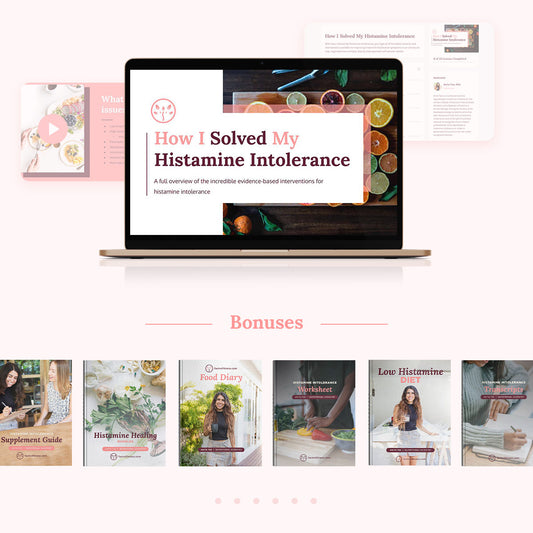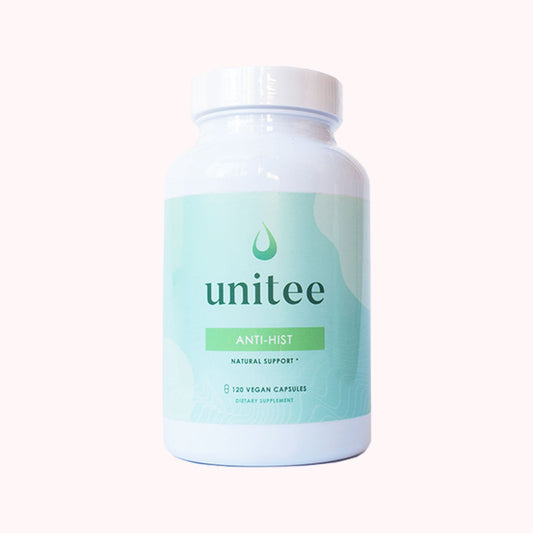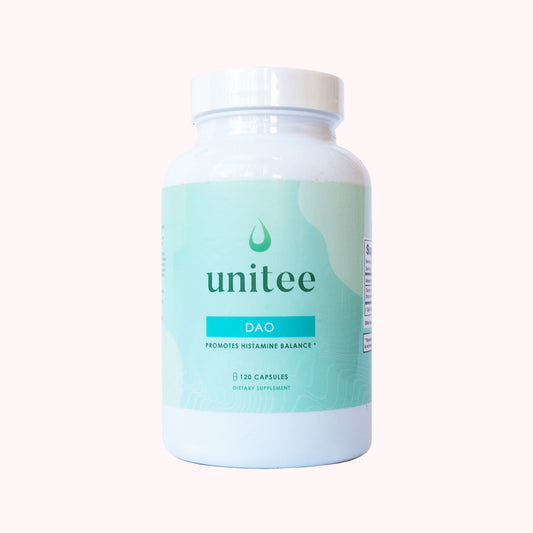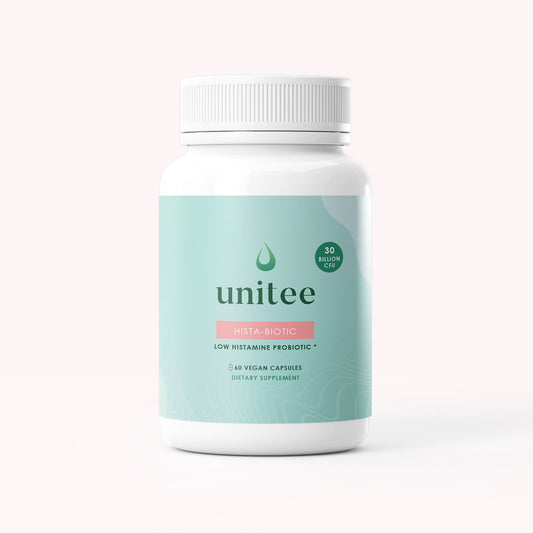Coffee isn’t simply a drink. It’s a culture.
For many, it brightens up their day. It can give you a boost in your step. It’s associated with connection and friendship. It can even take you on an emotional journey.
If you’re anything like me, you probably miss coffee. I’m sure you, just like me, loved to sip on a cup of java before you suddenly couldn’t tolerate it anymore due to becoming histamine intolerant. Perhaps you, too, wonder if coffee is high in histamine or not.
Well, if you’ve tried it in the last little while, you know it’s likely an absolute no-no when it comes to living with histamine intolerance. It can cause jitter, palpitations, sweats, anxiety, nausea and a whole whack of other bothersome symptoms. This leaves many people questioning: Is coffee high in histamine?
There are generally 3 reasons people may feel a histamine flare when drinking coffee.
Today, my team of scientists and I are going to dig into those reasons a little more so you may understand why it could be causing you to react the way you do.
Is Coffee High in Histamine?
This is the confusing part: coffee is actually not naturally high in histamine. Well, correction, the beans - or more accurately, the seeds from the coffee cherries - that coffee is made from, are not naturally high in histamine. So, while coffee itself isn’t naturally high in histamine, certain brewing methods can result in coffee high in histamine, exacerbating histamine intolerance symptoms. It’s what happens to these seeds when turned into beans that changes the histamine content. And this can take place in three ways.
1. The cherries are fermented, which can result in coffee high in histamine.
Once the berries are harvested, ready to remove the seeds to roast and become those little brown beans that smell so good, they need to be fermented. It’s an integral part of the process of becoming coffee, and greatly affects the taste of the final product (1).
I’m wondering what your experience is with peeling ripe cherries, or ripe fruit in general? Those skins are stuck tight, aren’t they! Well, fermenting the fruit even a little allows it to soften and the skin and flesh is easier to remove. When it comes to coffee cherries, the fruit itself is of little use, so the fermentation process is a simple way of quickly ripening the fruit to provide easy access to the all-important seeds. A small amount of fermentation can affect the seeds, depending on the length of time the cherries or seeds need to be fermented, which can persist into the coffee beans you’ve purchased.
And you know all about fermentation as part of your low histamine diet, don’t you? Any type of fermentation allows bacteria to grow and increases the biogenic amine content of the food. Histamine is one of the most bothersome biogenic amines when it comes to histamine intolerance. So, coffee high in histamine might be a result of this fermentation process.
2. Caffeine itself can cause histamine issues.
The energizing component of coffee, caffeine, is well-known for its ability to disrupt sleep. And interestingly enough, it has been shown to have a significant impact on histamine receptors in the brain.
If you remember back to what you know about histamine and the sleep-wake cycle, you’ll recall that histamine is an essential neurotransmitter involved in keeping you awake. Once it binds to the histamine receptors in the brain, histamine triggers wakefulness. Caffeine can bind to those receptors too (2). In fact, research in an animal model shows histamine levels in the brain may rise approximately 80% just 30 minutes after caffeine administration (3). 2 hours later, those histamine levels continue to be significantly elevated. It was only after around 3 hours post caffeine administration that histamine levels began to represent their pre-caffeine ranges!
If you’re already struggling with histamine issues, you can imagine why this sudden influx of high doses of histamine can cause you to feel unwell after adding caffeine to the mix.
3. You may be exposed to other histamine liberating or containing compounds in your coffee.
Depending on how the beans are processed and stored, there may be a risk of exposure to mold or yeast when drinking coffee (4). Of course, for those without histamine intolerance, it may not be an issue as it could really simply be trace amounts. For those of you with sensitivities to histamine, even the minute amounts can cause dreadful flares of your symptoms! In this case, it may not even be the coffee’s fault; it could be the mold or yeast contamination.
As you can see, answering the question whether coffee is high in histamine is a little complicated. And you may be left wondering if there's a way you can still enjoy even a small amount without it leaving you in a histamine flare!
Let me break that down for you…
Enjoying Coffee High in Histamine When You Have Histamine Intolerance: Tips and Tricks
When I started getting more control over my symptoms of histamine intolerance by discovering the root cause of my condition and following a strict low histamine diet, I started to wonder whether I could tolerate coffee again.
Because I did the research, I was able to understand the three reasons mentioned above, that may have contributed to my caffeine-histamine flares. So, here’s what I did:
1. I bought organic, small-batch beans.
Even though all coffee cherries will go through some sort of fermentation process, I was at a place in my histamine intolerance journey where I wasn’t having many histamine flares. I thought about the short process in which some coffee roasters would expose their beans to fermentation and considered this in my selection.
2. I opted for decaffeinated options.
Decaffeinated coffee has a very small amount of caffeine, which reduces the risk of caffeine-stimulated histamine receptor responses. But there is something extremely important to know about decaffeinated coffee: how the caffeine was extracted! In some commercial coffees, the caffeine is removed from the beans using toxic chemicals such as solvents. While manufacturers claim there’s no harm to the end user, even tract amounts of this toxin can be harmful to human health and cause flares in those who have histamine intolerance because of the burden they may put on your liver. It’s for this reason I always select a brand that removes their caffeine using a Swiss Water Process, no toxic chemicals in sight.
3. I looked for coffee brands that provided results from testing for mold, yeast and bacteria.
Many small batch or artisanal coffee roasters will regularly test their coffee for contaminants. It is important to know whether the organic, small batch, Swiss Water Decaf option you decide to try does so, too.
Remember, it’s not only about the coffee itself when it comes to histamine intolerance flares; what you put into the coffee will have a dramatic effect on your body’s reaction to the drink.
Instead of dairy milk, which many of those living with histamine intolerance are sensitive to, use unsweetened coconut or macadamia nut milk. Forgo any sweeteners or added toppings! If you can’t go without, add just a touch of honey or stevia, if tolerated.
Enjoying My Coffee to This Day!
I’m thankful to say I’ve been living without the symptoms of histamine intolerance for a while now. Of course, I continue to be mindful of the events leading up to my condition, and make a concerted effort to manage the underlying factors that were at play.
But, because I was able to make changes to my diet, manage my stress, enhance my sleep and tackle those underlying causes of my histamine intolerance, I was able to slowly introduce more foods (and drinks!) into my diet that may have increased my histamine levels.
Starting with just a small cup of decaffeinated coffee a couple of times a week, I can now treat myself to a caffeinated cup when I need to, all without the dread of symptoms.
I hope, as a fellow coffee lover, that you’re able to do so, too, one day.
References:
1. Elhalis, H., Zhao, J., Cox, J. Coffee fermentation: Expedition from traditional to controlled process and perspectives for industrialization. Applied Food Research. 2023. 3(1):100253.
2. Teraoka, H., Akiba, H., Takai, R., Taneike, T., Hiraga, T., & Ohga, A. (1997). Inhibitory effects of caffeine on Ca2+ influx and histamine secretion independent of cAMP in rat peritoneal mast cells. General Pharmacology: The Vascular System, 28(2), 237–243. doi:10.1016/s0306-3623(96)00186-3
3. John J, Kodama T, Siegel JM. Caffeine promotes glutamate and histamine release in the posterior hypothalamus. Am J Physiol Regul Integr Comp Physiol. 2014;307(6):R704-R710. doi:10.1152/ajpregu.00114.2014
4. Beugre, GC, Kahjo, AC, et al. Sensory Quality of Coffee Beverage Produced Thereof Linked to the Inhibition of Molds Growth and Ochratoxin a Removal from Coffee Cherries Using Lactobacillus Plantarum Strains. Current Journal of Applied Science and Technology Volume 42, Issue 13, Page 10-20, 2023;Article no. CJAST.100341ISSN: 2457-1024.

Anita Tee
My name is Anita Tee. I'm a nutritional scientist who specializes in histamine intolerance. I hold a Master of Science in Personalized Nutrition and a Bachelor of Science in Human Biology and Psychology.
For the past ten years, I have used my experience in nutritional and medical health sciences to create a scientifically backed, natural approach to healthcare that relies 100% on evidence-based research.
As I previously suffered from - and overcame - histamine intolerance, my focus is to increase recognition and expand the available resources and protocols available for resolving this particular disorder. To date, I have helped over 4,000 individuals fully resolve or better manage their histamine intolerance symptoms.







